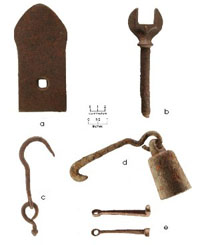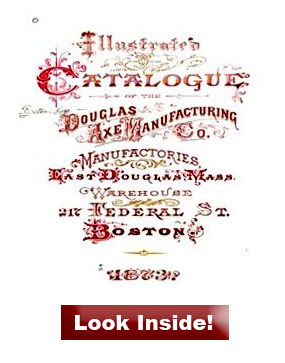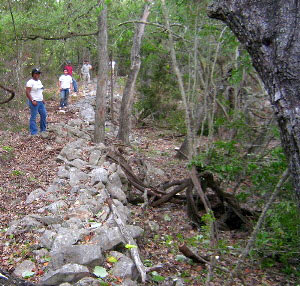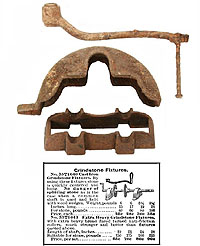
Other tools found at the farm include part of a plow (a), clevis wrench (b), and parts of a cotton scale, used for weighing, including the hanger hook (c), counter weight (d), and hanger hinges (e).  |

This worn out old axe was used both for chopping wood and as a wedge, for splitting wood.  |
|
The archeologists identified the rusted pick mattock found at the farm in an 1873 tool catalogue, based on the name, "Hunt," stamped on the tool. It was manufactured by the Douglas Axe Manufacturing Company in Massachusetts. 
 In order to till the land, some form of plow was needed. Archeologists found a piece of a plow called a jointer blade. In order to attach the farm machinery to the horse or mule, a clevis was used; in this case a clevis pin wrench. This multifunctional tool was used to tighten various nuts and bolts on the machinery. Other tool parts found at the farm were from a scale used to weigh crops, such as cotton. In order to till the land, some form of plow was needed. Archeologists found a piece of a plow called a jointer blade. In order to attach the farm machinery to the horse or mule, a clevis was used; in this case a clevis pin wrench. This multifunctional tool was used to tighten various nuts and bolts on the machinery. Other tool parts found at the farm were from a scale used to weigh crops, such as cotton.
The Williams men probably cut a number of trees on the farm, using some of the wood to build their cabin. They also needed a steady supply of fire wood for cooking and heating the cabin. For these tasks they needed a strong axe.
 Archeologists found a steel axe head at the farm, but its butt end was split open and battered from heavy use. Its primary function was as an axe, but it also had been used as a wedge for splitting wood. Archeologists found a steel axe head at the farm, but its butt end was split open and battered from heavy use. Its primary function was as an axe, but it also had been used as a wedge for splitting wood.
The wedge-like tool also would have been useful for prying out rocks to be used in fences. There were rock fences all over the Williams farm! As shown in the photo below, on the left, archeologists surveyed and took measurements and notes on all the fences. |

Archeologists used this 1873 catalogue to help identify the pickaxe head they found at the farm.  |

Farmers needed to keep all their tools sharpened. To do this, they needed a grindstone. The grindstone at the Williams farm may have looked like this.  |
|
 The Williams farm must have been a very busy operation! Archeologists found many types of tools used for gardening and farming in the fields. While some work had to be done by hand, other work was done with machinery, such as a plow pulled by horses and mules.
The Williams farm must have been a very busy operation! Archeologists found many types of tools used for gardening and farming in the fields. While some work had to be done by hand, other work was done with machinery, such as a plow pulled by horses and mules. ![]()



 In order to till the land, some form of plow was needed. Archeologists found a piece of a plow called a jointer blade. In order to attach the farm machinery to the horse or mule, a clevis was used; in this case a clevis pin wrench. This multifunctional tool was used to tighten various nuts and bolts on the machinery. Other tool parts found at the farm were from a scale used to weigh crops, such as cotton.
In order to till the land, some form of plow was needed. Archeologists found a piece of a plow called a jointer blade. In order to attach the farm machinery to the horse or mule, a clevis was used; in this case a clevis pin wrench. This multifunctional tool was used to tighten various nuts and bolts on the machinery. Other tool parts found at the farm were from a scale used to weigh crops, such as cotton. 


